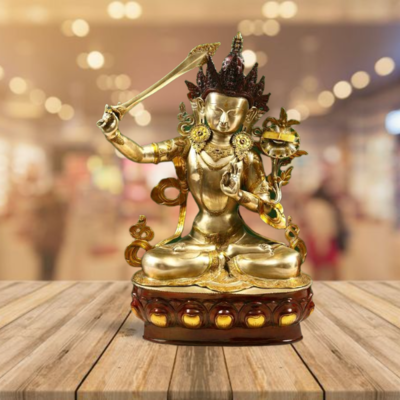|
This forty inches high and twenty-six-inch wide brass statue represents one of the early forms of Manjushri, the Buddhist god who stands for wisdom and knowledge, more particularly the knowledge of linguistics and grammar. The image of the deity, with its two arms and the book Prajnaparamita, carried over a lotus, pursues the initial idiom of Manjushri imagery. One of the would-be Buddhas, Manjushri also symbolized, like other Boddhisattvas Avalokiteshvara, Maitreya, Padmapani, etceteras, different stages of soul's attainment of Buddhattva. In early innovations, Manjushri images had normal two arms, and only rarely four, carrying in one of them a 'khadaga', sword, and in the other the book Prajnaparamita. Sometimes the book was carried over a lotus, and the arm other than the one, which carried 'khadaga', had a diamond Ratna-mani or Chintamani, which symbolized truth, as, like truth, it neither rusted nor defaced or eroded. With the sword, Manjushri is conceived as eliminating darkness, and with the book, as spreading true knowledge. Later, when Manjushri emerged as one of the main Tantrika deities, particularly in Tibetan Buddhism widely pursued in the northern regions of Himalayan hills, the anatomical and iconographic perception of the image underwent a radical change.
Goddess Manjushri: https://www.exoticindiaart.com/product/sculptures/39-large-size-manjushri-bodhisattva-of-transcendent-wisdom-tibetan-buddhist-deity-handmade-zdq04/
|



